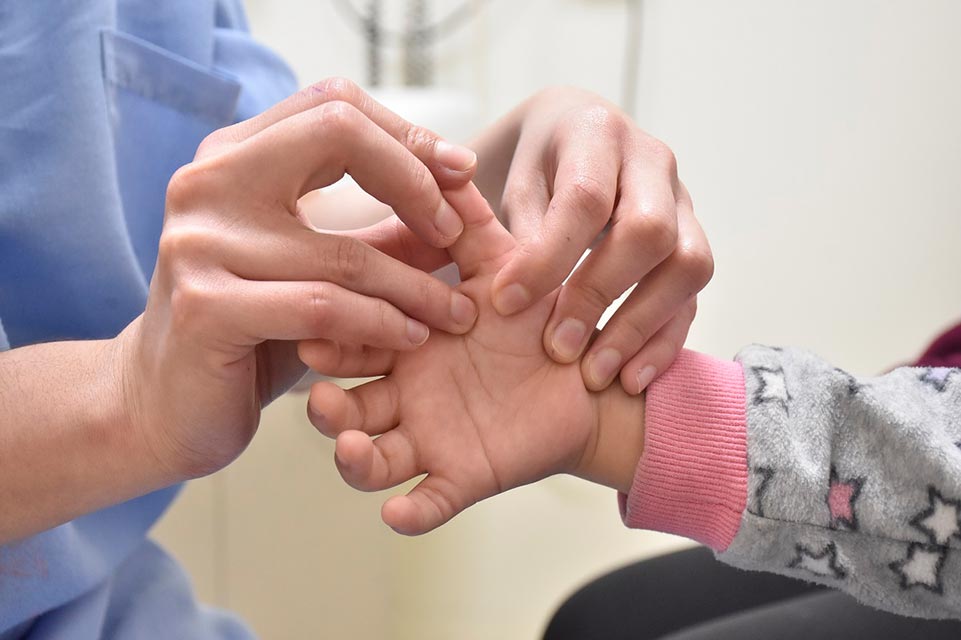Treating Syndactyly and Polydactyly

Syndactyly is rare and occurs in one or two births per 3,000.
Syndactyly is a deformation where one or more fingers of the hand are united or fused at birth. In the case of polydactyly, it presents as the division or bifurcation of the thumb or long fingers (index, middle, ring or little finger).
Syndactyly is rare, as it occurs only in one or two births per 3,000. Polydactyly is different and has an incidence of one or two per thousand births. In the vast majority, men have a higher incidence.
Types and Detection
Both deformities can be divided into simple and complex; and into complete and incomplete. Simple syndactyly is characterized by fusion of the fingers by skin or soft tissue only. In complex syndactyly, the bone is also fused.
“Here it is extremely important to evaluate the patient to see if a separation can be made without affecting function,” said Daniela Velázquez-Aréstegui, M.D., a pediatric orthopedic physician at the Mexico Shriners Hospital, who specializes in hand deformities.
Complete syndactyly is when the union of the fingers reaches the nail, and incomplete syndactyly is when the union of the fingers does not reach the nail. In some cases, duplications of the finger can be detected during the obstetric ultrasound, but in the case of syndactyly, it is very difficult to detect if the baby's fingers are fused together.
Why does syndactyly or polydactyly occur?
When the hand is formed in the womb, at approximately four weeks the formation of the fingers begins. Due to an overexpression or lack of expression of the genes that control the formation of the fingers, they become duplicated or fused. Some cases are associated with syndromes, but the exact cause is not really known.
“We do not know if it is due to diet, genetic alterations, etc. If the parents had polydactyly, it is rare that they can pass it to their children. However, in the case of syndactyly, there can be a pattern of inheritance to the children,” explained Dr. Velazquez.
In 2021, 58 surgeries were performed for syndactyly and 36 for polydactyly at the Shriners Hospital in Mexico.
What is the best age to treat syndactyly and polydactyly?
Treatment is recommended before skeletal maturity, from 6 months to 4 years old, so that the hand has full function and recovery. This is useful so school-age patients do not require any surgery and there is no aesthetic loss. However, at the Mexico Shriners Hospital, both conditions can be treated up to 18 years of age.
Treatment of Syndactyly and Polydactyly
In the case of syndactyly, surgery includes making a Z-shaped cut to separate the fused fingers. Skin grafting from the wrist or groin is usually needed during surgery, because the area of skin that covers the fused fingers is not the same once they are separated. In the case of polydactyly, the duplicated structures are removed, always taking care that the remaining fingers have adequate fusion.
The Importance of Occupational Therapy
After hand surgery, doctors rely on occupational therapy, especially in cases of syndactyly, since the fingers, until then, are used to working together. Part of the therapy includes helping the patient to get used to moving their fingers separately and gaining strength in each one. In the case of polydactyly, the finger that remained is strengthened and gains mobility. “It is very important that parents get involved in occupational therapy, and that they carry out their therapies at home, because that way they will obtain better results,” explained Dr. Lourdes.
The Mexico Shriners Hospital staff works hard to make therapy as fun and beneficial as possible, with recreational activities that are interesting for the patient and ensure that rehabilitation is quick and high-quality.
The Message
Finally, Dr. Velazquez recommends that parents seek timely treatment for patients with these conditions, because the earlier they are detected and treated, the better the long-term outcome will be.
Keep In Touch
Join our mailing list to stay up to date on everything that's happening at Shriners Children's.
